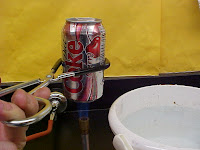I start the Chemistry unit with phases of matter. Things we can see. My text book starts with parts of the atom and how they were discovered. I prefer to start with what we can see, then go into the theory and the discoveries.
States of matter. SOLID, LIQUID, GAS. Phase change: Melting, Boiling, Freezing, Sublimation and Deposition. Expansion of heated objects. It can be a lot of fun.Here is how.
After notes on the kinetic theory (all matter made of tiny moving particles) students go to the lab stations and literally
BIMETALLIC STRIP bends with heat as one metal expands faster, then shrinks and straightens the metal when cooled. Fun! Big bang for the buck. (that means kids love it and it is easy to set up..YES IT IS STANDARDS BASED BUT I'D DO IT IF IT WASN'T!).This shows heating expands matter and cooling will shrink matter, also shows that some metals absorb heat faster than others.

BALL AND RING (or rod and slot) Ball (rod) barely fits in the hole (slot) when cool. When heated the ball (rod) expands and no longer fits in the hole (slot). This shows heating expands matter and cooling will shrink matter
ALUMINUM CAN IMPLOSION. Heat the soda can (make sure it is rinsed of all soda and has a touch of water inside) for about 20 seconds, just enough to heat and boil off the water, steam comes out, you hear sizzling, and QUICK IMMERSE IT UPSIDE DOWN IN THE BUCKET OF WATER AND PHLOOM ...IT IMPLODES.
I tell the kids that this demo sucks. It does. The can and air inside cool so quickly that water does not have enough time to be sucked in so it sucks the walls in instead. This shows cooling will shrink matter.
FIVE METAL WAND OF HEAT CONDUCTION. This shows how Aluminum, Copper, Brass, Nickel and Steel (Iron) conduct heat at different rates. Each rod end is dipped in melted wax ,from a candle, and then the wand is placed over the bunsen burner and you time how long it takes for the wax at the tip to melt. Copper goes first at about 25 seconds and Nickel takes almost 3 minutes. This shows heating expands matter and that some metals absorb and transfer heat faster than others.
In the last photo you can see that Copper (near left) has already melted and that Aluminum (near right) is in the process of just starting to melt the wax.
I hope this helps.
Love to Teach and Teach with Passion.
It's not Magic, It's Science.






No comments:
Post a Comment